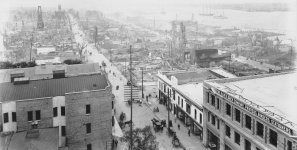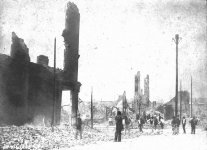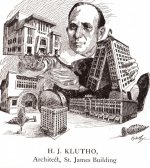It appears we might have one additional "appointee" of an architect in the history of the after-fire rebuilding. This time we have this gentleman named Henry John Klutho. Mr. Klutho assisted with rebuilding Jacksonville after the Great Fire of 1901. The fire was truly devastating, and is considered to be the third worst in the history of all the Great Fires which took place in the United States. Jacksonville was only topped by 1906 San Francisco, and 1871 Chicago.
A few facts about the Great Fire of Jacksonville: In eight hours, the fire burned 146 city blocks, destroyed more than 2,368 buildings, and left almost 10,000 residents homeless. Seven human deaths were reported. (death rate is border line ridiculous obviously)
This Fire appears to be a classic case similar to the one in Seattle in 1889, and a whole bunch of other ones. No need to talk about all those trees, and utility poles surviving the inferno. This article is about Henry John Klutho.
Henry John Klutho was an American architect known for his work in the "Prairie School" style. Klutho was born in Breese, Illinois, a small midwest town. He lived there until the age of 16, when he left for St. Louis, Missouri to study business. When he became interested in architecture, he moved to New York City to learn more, and became an architect.
Klutho read about the Great Fire of 1901 in the New York Times and recognized the opportunity of a lifetime. He finished his current projects in New York and quickly moved to Jacksonville. Klutho introduced himself to prominent businessmen and politicians, and within a month, he was commissioned to design the six-story Dyal-Upchurch Building, the first large structure in the barren downtown area. Other projects soon followed, including the new City Hall and private homes.
His contributions to the rebirth of the city were mostly ignored, except by his colleagues. Klutho lived to be 91, but had little money, making his later years difficult. Following his death, much of his work was razed or "renovated". - Wikipedia
1. He died in 1964. There is only ONE photo that I found. How is it possible?
2. This guy resembles Elmer Fisher way too much.
3. Questionable education and background.
4. Sad life finale, which is very common with these appointees.
I have not looked too deep into the Jacksonville Fire and Mr. Klutho, but a quick scan of his story appeared to fit the profile.




